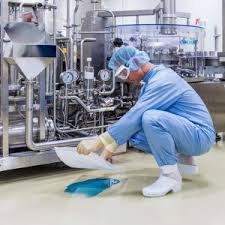Handling and Control of Spills in Pharmaceutical Manufacturing Environments

Handling and Control of Spills in Pharmaceutical Manufacturing Environments
1. Introduction
Spillage in pharmaceutical manufacturing can lead to contamination, safety hazards, equipment damage, and regulatory non-compliance. Proper handling and control of spills is essential to maintain product integrity, ensure personnel safety, and uphold Good Manufacturing Practices (GMP).
2. Objectives
-
Prevent cross-contamination and product quality compromise.
-
Ensure a safe working environment for personnel.
-
Comply with regulatory standards (e.g., FDA, EMA, WHO GMP).
-
Minimize disruption to production activities.
3. Types of Spills
-
Chemical Spills: Acids, bases, solvents, reagents.
-
Product Spills: Active pharmaceutical ingredients (APIs), intermediates, excipients.
-
Biological Spills: Cultures, cell lines, biological products.
-
Water or Utility Leaks: From HVAC, purified water systems, or drainage.
4. Classification of Spills
-
Minor Spills: Small quantity, non-hazardous material, easily contained.
-
Major Spills: Large volume, hazardous/toxic substances, risk of contamination or injury.
5. Spill Management Procedures
A. Immediate Response
-
Assess the Situation:
-
Determine the nature and extent of the spill.
-
Identify any immediate risks to personnel or product.
-
-
Raise an Alert:
-
Notify supervisors and Quality Assurance (QA).
-
Trigger emergency response if necessary (for toxic or flammable materials).
-
-
Personal Protective Equipment (PPE):
-
Use appropriate PPE based on spill type (e.g., gloves, masks, goggles, coveralls).
-
-
Evacuate if Needed:
-
In case of hazardous chemical spills, evacuate area and isolate if possible.
-
B. Containment and Clean-up
-
Contain the Spill:
-
Use absorbent pads, spill kits, or dikes.
-
Prevent spread to drains, equipment, or adjoining rooms.
-
-
Clean-Up:
-
Follow specific clean-up procedures for chemical or biological spills.
-
Use appropriate disinfectants or neutralizing agents.
-
Dispose of waste as per hazardous waste disposal protocols.
-
-
Decontaminate the Area:
-
Wipe down surfaces and equipment.
-
Use approved cleaning agents to remove residues.
-
-
Ventilation:
-
If volatile chemicals are involved, ensure proper air circulation.
-
C. Documentation and Reporting
-
Incident Report:
-
Record the spill details, cause, quantity, response, and corrective actions.
-
-
Root Cause Analysis (RCA):
-
Conduct investigation for major or recurring spills.
-
Identify preventive actions to avoid recurrence.
-
-
QA Review:
-
QA to review and approve documentation.
-
Update risk assessments or procedures as needed.
-
6. Roles and Responsibilities
-
Operators: Immediate response, containment, initial reporting.
-
Supervisors: Oversight, communication, ensuring procedures are followed.
-
QA/QC: Documentation, investigation, and regulatory compliance.
-
EHS (Environmental Health & Safety): Hazard evaluation and training.
7. Spill Kits and Preparedness
-
Each area should have readily accessible spill kits.
-
Kits should include:
-
Absorbents
-
Neutralizers
-
PPE
-
Waste bags
-
Labels and instructions
-
-
Training:
-
Regular training on spill response.
-
Drills to assess readiness and effectiveness.
-
8. Regulatory Considerations
-
GMP Compliance:
-
SOPs for spill handling are a GMP requirement.
-
Spills impacting product must be part of deviation management.
-
-
Environmental Regulations:
-
Proper disposal as per local environmental laws.
-
-
Occupational Safety:
-
Adherence to OSHA or equivalent standards for chemical exposure and response.
-
9. Preventive Measures
-
Routine maintenance of equipment and facilities.
-
Proper material handling practices.
-
Clearly labeled containers and storage areas.
-
Adequate training for all personnel.
-
Designated traffic patterns to avoid congestion and accidents.
10. Conclusion
Effective handling and control of spills in pharmaceutical environments is not just a matter of cleanliness—it’s a critical component of safety, compliance, and quality assurance. A well-defined and consistently applied spill response program protects products, personnel, and the company’s reputation.
🎓 Discover one of the best Pharmaceutical Production courses available — click below to explore the course that’s shaping future Production skills.

